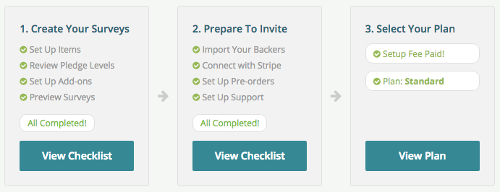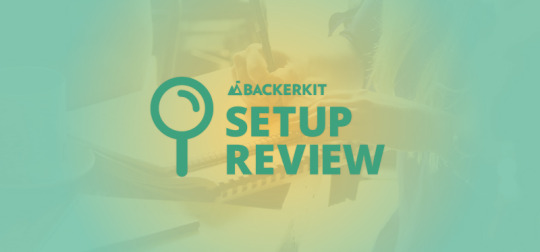One of the services we provide to project creators is a final setup review before sending out survey emails. Most project creators are able to build fantastic surveys just by following our Quick Start Guide, reading our help documents, and consulting with our customer success team, but we still perform the final review to make sure that backers have the best survey experience possible and that creators get structured data after surveys are completed.
Items & SKUs
This first step is where we verify that all of the campaign items are accounted for in the survey setup. We read through the project campaign page and record all pledge reward items, stretch goal items, and all variations to make a list of unique items offered in the campaign. Then we load up the project in BackerKit and go through the Quick Start Guide step by step. This is the exact same guide project creators follow when they first build their survey.

Items are first on the list. We check the SKU (stock-keeping unit) list to see if all of the items from the campaign are present in the BackerKit survey.
If any items are missing, we’ll ask the project creator if they were omitted by mistake. Sometimes the creator forgets to include an item. Other times the missing item may be bundled with another item, like a book that comes with a bookmark attached to the book cover. The book itself will appear in our system as one SKU but it will account for two items, the book and the bookmark.
Pledge Levels
Next we review each pledge level to see if rewards are properly assigned. If a reward item does not have any variations or customization involved, the SKU should be assigned directly to the pledge level in the “Pledge Items” field. These are the items don’t require input from the backer to select.

If there’s reward customization of any kind, there should be a pledge question with SKUs assigned to each answer. We look at each pledge question to see if the question is legible, makes sense to the backer, and that the correct SKUs are assigned to each possible answer. If there’s a t-shirt pledge question with two colors and three sizes, we’ll look to see if all six variations have been assigned to their corresponding answers.
We also need to verify that questions are structured correctly to minimize work later when the creator needs to process orders. For example, let’s say that you need to ask your backers to select what color dragon figurine reward they want. If you create this question as a free-form text response question where the backer can type in a color, you’re going to be buried in work later because you’ll have to parse each answer by hand. If you switch it to a multiple choice question with a list of colors, you can assign a SKU to each answer to make it easy to generate your orders and item counts automatically.
We finish up the pledge level review by verifying that the shipping fees are correct and that the survey only asks for address information from backers that are receiving physical goods.
Add-On Items
We examine the add-on items to verify that they all have images and legible descriptions, and we take a look at the prices and shipping fees to make sure that they make sense. (This is when we ask the creator if they meant to offer free international shipping on a 20 lb. item.) We also need to see if each add-on has an assigned SKU or that all item variants have the correct SKU assigned.
Creators have the option to make individual add-ons visible to select pledge levels. For example, if you want to offer the same item at two different prices, a lower, $20 price for the early-bird backers and the normal, $25 price for the regular tier backers, you’d create two add-ons items with different prices and make each item only visible to backers in their assigned pledge level. We double-check the visibility settings for each add-on to make sure the correct add-ons are visible to specific backer pledge levels.
Pre-Orders & Support
If the creator is using the BackerKit hosted pre-order store, we’ll check the item list and shipping fees to make sure that everything is in order. We also check the settings page to verify that the creator has entered in the project’s Twitter handle and Facebook page to power the social sharing features.

Finally, we review the support page to make sure that the creator has set a support email address and entered a survey lockdown date. The BackerKit platform significantly reduces the volume of support tickets but we still need a support address to resolve inquiries that only the creator can answer such as questions about product specifications. The lockdown date tells backers how much time they have to complete their surveys.
Once we complete the review, we contact the project creator to clear up any issues that we find and then set the project status to “live” which allows the creator to email surveys out to backers.
Looking Out for Backers and Creators
The setup review is an essential part of the BackerKit process. It allows us to catch and fix any problems in the survey before it goes out to backers. This ensures that backers see a survey that makes sense and accounts for all of the pledge rewards that they’ve been promised and that project creators get clean, structured survey data that makes the fulfillment process easier down the line.
Are you intimidated by the survey creation process? Talk to us to find out more about our powerful survey tool and how we help project creators get through the fulfillment process!
